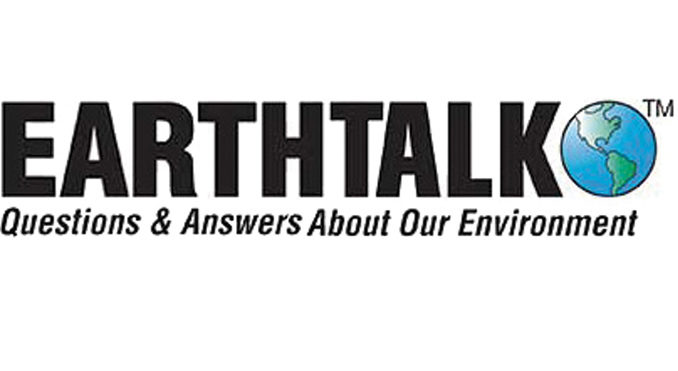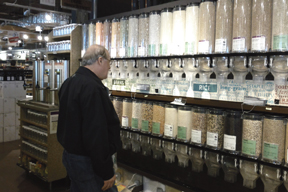

Credit: Richard Droker, FlickrCC.
Dear EarthTalk: I am sickened by all the death, destruction and misery resulting from the West Coast wildfires, but aren’t these blazes actually beneficial to the environment? ~ B.T., Helena, MT
Some landscapes evolved with periodic wildfires as an influential force, and people have been using “prescribed burns” (the controlled application of fire under specified weather conditions) to restore health to certain types of ecosystems for millennia. But while some fires in some places might be beneficial, the wholesale torching of the forests of the American West right now is far from beneficial overall—not to mention a sure sign that our profligate ways with carbon emissions are coming back to haunt us.
On the plus side, forest fire does clear away the tinder-like overgrown understory that has resulted from years of forest management that avoided fire at all cost. Hundreds of years ago, many of the forests now on fire in California, Oregon and Washington had fewer yet larger and healthier trees. But these days, partly thanks to fire suppression regimes as well as other factors, forests are more crowded today with smaller, less healthy trees. It’s also harder for those remaining mature, established trees to compete for nutrients and space with all the undergrowth that’s built up in recent decades. In these situations, small manageable fires (or even better, prescribed burns) cannot only be beneficial, but can help prevent larger fires down the road by clearing the weaker, smaller trees.
Another benefit of wildfire is the clearing of overgrown underbrush to make room for new grasses, herbs and regenerated shrubs that provide food and habitat for many wildlife species. Also, the removal of thick stands of shrubs increases the water supply for the remaining larger plants and trees—and also allows streams and rivers to swell, further benefiting ever-thirsty native flora and fauna.
Yet another benefit of fire is that it kills off fungi, bacteria, viruses and insects that can decimate tree and plant communities and entire forest ecosystems. According to CalFire, California’s statewide wildfire management agency, more trees die from insect infestation and disease than from wildfire; some fire actually helps keep forests devoid of such pests and healthier overall than without fire. CalFire points out that vegetation burned by wildfire provides a rich source of nutrients that nourish surviving trees and soil.
And periodic fire can be an important way to keep certain ecosystems in balance. Many trees have evolved with fire and some even require it for seed germination; a few species even sport leaves covered with flammable resins (manzanita, scrub oak, chamise) to encourage fires that help seed the next generation.
National Geographic reports that, surprisingly, wildlife casualties tend to be low during wildfire events, as animals—especially those native to the areas on-fire and evolved to respond to the threat—either burrow in the ground or flee to safer areas instinctively. But invasive plants and animals may not fare as well given lack of genetic imprinting to be on alert for the threat.
Once the smoke clears on 2020’s horrific fire season, mass human and wildlife casualties could be the new normal. Global warming certainly has thrown the fire season into overdrive this year across California, Oregon and Washington, whether or not the Trump administration cares to admit it.
CONTACTS: CalFire, https://www.fire.ca.gov/;
“The Ecological Benefits of Fire,” https://www.nationalgeographic.org/article/ecological-benefits-fire/.

Dear EarthTalk: Any tips for reducing the amount of disposable plastic I use for food storage? ~ J. Spencer, Gaithersburg, MD
Analysts estimate that of the over six billion tons of plastic produced worldwide since the 1950s, we have recycled only nine percent of it and incinerated another 12 percent. The remaining, some 4.8 billion tons of plastic is either still in use, filling up landfills, or littered into streets, streams and eventually the ocean.
About a third of the plastic produced worldwide is for single-use applications (bottles, bags, utensils, food storage, etc.)—and it is these items that most commonly end up on the side of the road. Researchers discussed in a 2019 paper in Nature that if we do nothing to step up flagging efforts to reduce, reuse and recycle plastics, we could have three times as much of it littered into the global environment by 2060.
So, what’s an environmentally conscious consumer to do? For starters, avoid getting plastic bags at the store. Either bring your own reusable one or if you need to go disposable, at least opt for paper that can be recycled or composted. And if you are food shopping, gravitate toward the bulk items aisle where you can buy just the right amount without unnecessary extra packaging.
Another way to cut down on single use plastic is ditching plastic straws. Americans go through about 500 million plastic straws daily. Opting for reusable straws (metal, silicone, bamboo or glass, anyone?)—or no straw at all—is one of the simplest ways to cut down on disposable plastic.
According to the non-profit Center for EcoTechnology (CET), the kitchen is one place where you can definitely make some easy adjustments to save plastic. For starters, ditch the plastic wrap; it’s difficult to recycle and can clog recycling processing machines. One great alternative is beeswax paper, which is reusable, washable and compostable. (Make sure to wash it with cold water only so the wax doesn’t melt.)
“Another alternative to plastic wrap is storing your food in glass storage containers or glass jars,” adds CET. “Glass is 100% recyclable and can be recycled endlessly without loss in quality or purity.”
Putting dish cloths to use is another way to eschew plastic wrap for keeping produce fresh. Simply wrap up those fruits or veggies in a cloth instead of plastic—or put them in a bowl and cover with a dish cloth and rubber band for a tight seal—and put ‘em in the fridge.
One often overlooked environmental downside of the coronavirus situation is that restaurants throw in so much disposable plasticware for to-go and delivery orders—whether customers need it or not. That’s why a coalition of 120 environmental groups recently teamed up to send letters to seven national food delivery companies asking they change their default ordering process to one that does not automatically include utensils, napkins, condiments and straws in order to reduce the tsunami of single-use plastic pollution entering our oceans, landfills and incinerators.
CONTACTS: Future scenarios of global plastic waste generation and disposal, https://www.nature.com/articles/s41599-018-0212-7; “Zero Waste Substitutes to Eliminate Single Use Plastic in Your Kitchen,” https://www.centerforecotechnology.org/zero-waste-substitutes-to-eliminate-single-use-plastic-in-your-kitchen/.
EarthTalk® is produced by Roddy Scheer & Doug Moss for the 501(c)3 EarthTalk.
See more at https://emagazine.com. To donate, visit https://earthtalk.org.
Send questions to: question@earthtalk.org

